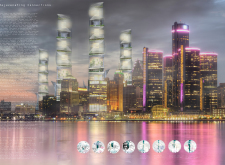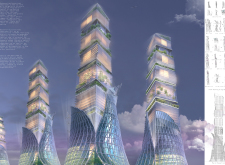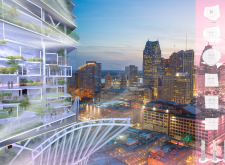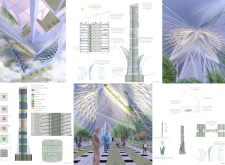5 key facts about this project
Rejuvenating Connections is a project located in Detroit, Michigan, addressing the issues of urban decline in the city. The design focuses on revitalizing areas marked by population loss and vacant buildings. By integrating nature into the cityscape, the goal is to reshape the typical environment of concrete structures into a more inviting and connected space for residents.
Design Concept
The design draws inspiration from elements found in nature, particularly tulip leaves and bamboo. The building's exterior is not just visually interesting but also serves a key functional purpose. It acts as a structural element that collects important resources like water, air, and sunlight. This approach helps to reduce the building's environmental impact while promoting harmony with the surroundings.
Spatial Organization
Inside the skyscraper, the layout is thoughtfully organized into different areas for living, learning, working, and recreation. These distinct zones aim to encourage social interaction and create a sense of community among residents. Each space is placed purposefully to foster engagement, ultimately reshaping the urban experience for those who inhabit it.
Sustainability Features
Sustainability is a critical aspect of the design, with integrated systems that manage air circulation and collect rainwater. These features contribute to a self-sufficient microclimate within the building. By prioritizing energy efficiency, the design supports a lifestyle that is mindful of environmental resources.
The use of composite materials in the construction lends the structure both strength and lightness. This allows for connections with neighboring buildings that go beyond mere physical links. They foster social interaction, encouraging a stronger sense of community within the urban environment.
The skyscraper includes multiple openings and atriums, designed to maximize natural light and provide views of the surrounding area. These design details create a pleasant living experience for residents, enhancing their connection to the city and its environment.






















































